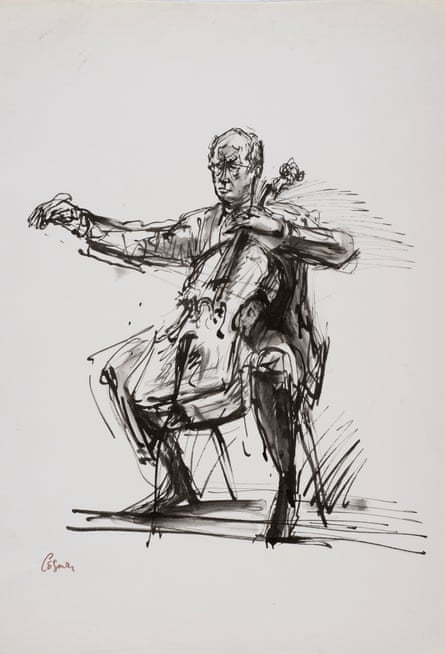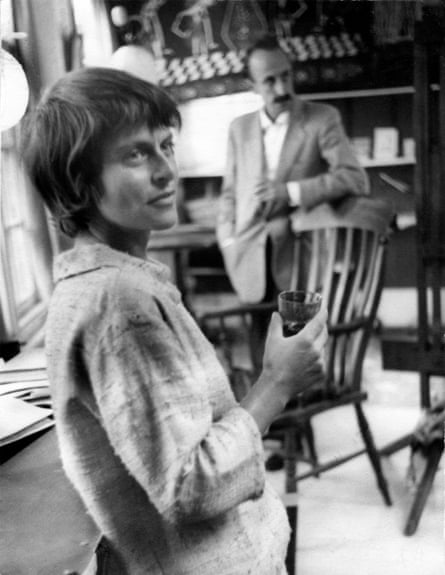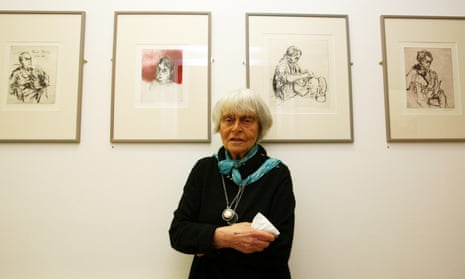Milein Cosman, who has died aged 96, drew many of the greatest artistic names of the 20th century. Working on commission for publishers, magazines and newspapers, she sketched Benjamin Britten, Yehudi Menuhin, Wilhelm Furtwängler, Sir Thomas Beecham, TS Eliot, Francis Bacon, Barbara Hepworth and Henry Moore, among others.
She drew primarily from life, and her subjects were mostly artists of various kinds, and above all musicians. Into this she was led by a love of music, but also by her almost 40-year-long collaboration with her Viennese husband, the musician, musicologist and broadcaster Hans Keller. Their book Stravinsky at Rehearsal (1962), which combined his words with her drawings, is a classic of a genre they largely devised themselves; he analysed the music, while she captured the musicians in the midst of its creation.

Cosman worked in ink, pencil and conté, and was never inhibited by the fame of her subjects: she drew Thomas Mann while he was lecturing; Sir Arthur Bliss conducting and John Ogdon at the piano. She worked extraordinarily swiftly, saying: “I can only draw fast. If I draw slowly, I almost always get it wrong. I think all the Stravinsky sketches were done in one day.” She also did many paintings, subjects including Stravinsky and Mstislav Rostropovich, the artist Fred Uhlman, and, most often, Keller.
In his appreciation of Milein’s work, published in the catalogue of her show of drawings and prints at the Belgrave Gallery in 1996, Sir Ernst Gombrich commented: “Posterity will be grateful to Milein Cosman above all for the sureness of her eye, with which she has succeeded in capturing the unique quality of so many of our distinguished contemporaries.” She claimed, however, that: “What I really like to draw best are people who work: fishermen and road menders. Yes, it must be said, that really a lot of people have quite wonderful faces.”
Emilie Cosmann (her brother nicknamed her “Milein” and she dropped the last letter of her surname when she came to Britain) was born into a comfortable German-Jewish family in the small town of Gotha, in Germany. She was educated largely in Düsseldorf, where she organised a pupils’ anti-fascist group and for her last two school years attended the Ecole d’Humanité and the International School in Geneva.
In 1939 she followed her brother, who was already installed in Scotland, to Britain. Thereafter, Milein always referred to herself as an émigrée rather than a refugee. Refugee was not the only label she refused to accept. “I’m not religious, I was brought up without religion, my religion is the arts,” she said, and: “I am not a ‘Jewish’ artist.”
After she gained entry to the Slade School of Fine Art – by turning up in person with her portfolio – she lived in a leaky garret behind the Ashmolean museum, Oxford, where the Slade was evacuated for the duration of the war. She studied drawing under Randolph Schwabe and lithography with Harold Jones, and in 1943 she alternated evening classes with Bernard Meninsky at Oxford Polytecnic with giving art classes for the Workers’ Educational Association. She supported herself by delivering milk with a pony and trap and teaching French at a convent school.

It was at Oxford, too, that she met Iris Murdoch, then a student, and was invited back for “cocoa at Somerville” after an evening lecture given by Graham Sutherland. Milein drew Murdoch’s portrait, commenting on the sharp features in the baby face, and the acute intelligence they revealed. This was the first lithograph Milein made, and demonstrated her ability to get under the skin of her subjects, to perceive more than perhaps they were aware of exposing.
While at Oxford, she met a constellation of musicians, artists and writers. The poet Sidney Keyes fell in love with her and dedicated some of his work to her. He was not the last poet to be struck by the tiny, lively-minded woman with birdlike movements and sharp intelligence. Years later, Dannie Abse was so impressed by a chance encounter in Zwemmer’s bookshop that he followed her all the way up the Charing Cross Road to pursue their conversation.
Milein moved to London at the end of the war, where she worked as an illustrator and began to submit sketches to magazines and newspapers. She became a regular contributor to the Radio Times, supplying portraits of the next week’s interviewees. Of Imogen Holst she said: “She looked quite funny, you know, in her sandals and ankle socks. She had the face of a Flemish Madonna.” Sometimes she generalised: “I find on the whole women quite difficult to do. They often have softer features – and very few of them are conductors”; of the cellist Rostropovich, she said: “He was marvellous to draw, as I believe cellists almost always are, crawling all over their instruments like beetles.”
In 1947, while working on a commission, she met Keller, who became her most frequent subject; his keenly angular, impish face adorned the small spaces of wall between the vast living-room windows of the Hampstead house which they bought in the 1960s, and where Milein stayed on alone after his death in 1985. With its unfolding rooms – French windows and a kitchen verandah giving on to a long front garden scattered with fruit trees – it had a German ambience often enhanced by the aroma of fresh poppyseed cake wafting through the open-plan modernist interior.

In 1958 Milein worked on a schools’ television series about drawing for ITV and in the 60s she joined Camden Printmakers, participating in numerous group shows. Her work was acquired by the Victoria & Albert Museum, the British Museum, the National Portrait Gallery and the Jewish Museum in London, and internationally by the universities of Texas, Pennsylvania, McMaster, Canada and Kanagawa, Tokyo.
Her cousin Leo Goldschmidt established the permanent exhibition of her work in the Palais des Beaux-Arts, Brussels, where he was the director, and there is another at Milein’s beloved Wigmore Hall, where she was a regular attender.
In 1986 Milein’s illustrations appeared in Klemperer on Music, and in 1998, in the John Heath-Stubbs 80th birthday issue of Aquarius.
As a sideline she devised a series of animals to which she added ludic descriptions: a Bird Flautist, Dancing Kangaroos, Dream Camels. She drew Britten’s parrot, for which she had to obtain not only Britten’s permission, but also that of his ill-tempered housekeeper, Miss Hudson, for access to “her” kitchen.
In 2006 she established the Cosman Keller Art and Music Trust to support education in these fields, and to preserve her work and that of her husband. It has recently bequeathed her drawings and prints of musicians to the Royal College of Music in London, drawings and prints of dancers to Salzburg University and a selection of drawings and prints to the arts academy in Berlin.
Despite encroaching blindness from the 90s onwards and a diagnosis of Alzheimer’s in 2011, Milein carried on working for as long as she could. In 2014 she attended the opening of a major retrospective of her work in Gotha, and a documentary on her life, directed by Christoph Böll, was funded by the city. An exhibition of her work is due to be held at Clare Hall, Cambridge, in 2019.
As she said, swiftly sketching a young child who came to her annual apple-picking party in 2003: “There’s always the thrill of the ink and the pen on the page.” Then, cocking her head to peer at what she’d just done: “It is a good drawing, isn’t it?”
Milein is survived by three nieces and a nephew.

Comments (…)
Sign in or create your Guardian account to join the discussion